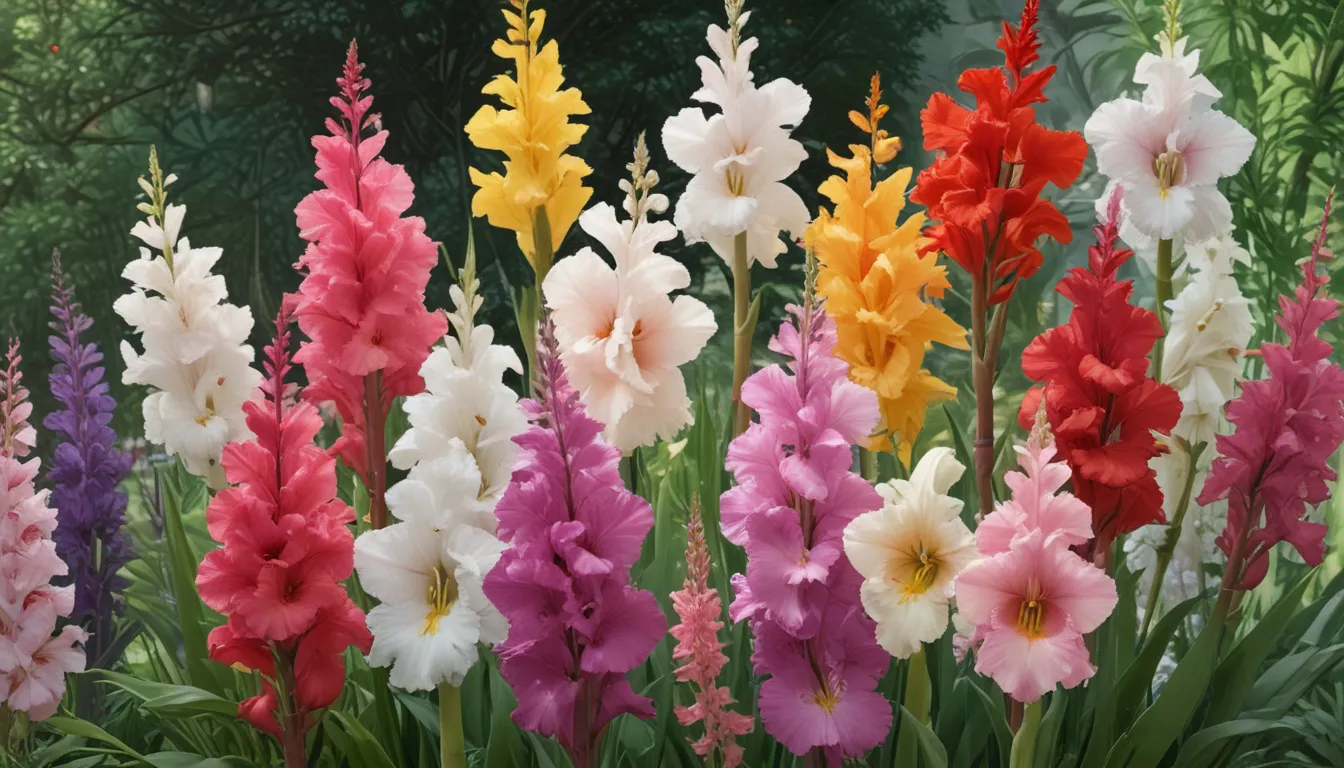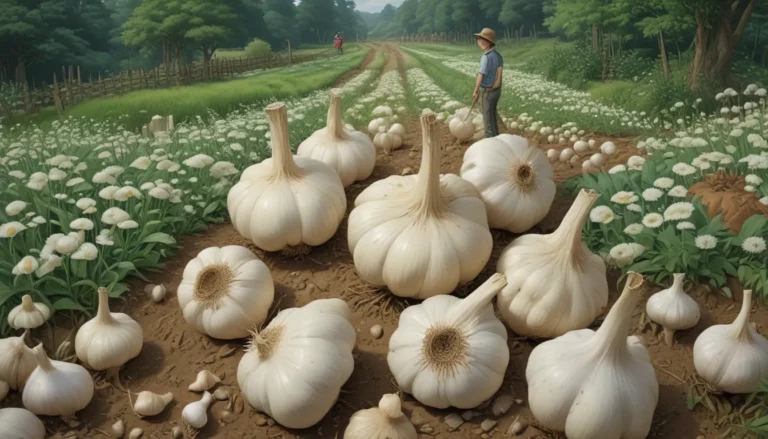Comprehensive Guide to Planting and Growing Gladiolus Flowers

Have you ever thought about adding a touch of vibrant color and vertical interest to your garden? Gladiolus flowers are the perfect choice! In this in-depth article, we’ll explore everything you need to know to successfully cultivate these beautiful flowers in your garden.
A Closer Look at Gladiolus Flowers
Gladiolus flowers, also known as gladioli, glads, or sword lilies, belong to the iris family, Iridaceae. These ornamental perennial plants grow from corms, which are thick underground stems that store food, similar to flattened bulbs.
With over 200 different species in the Gladiolus genus and countless hybrid varieties, these flowers have become popular staples in today’s gardens. From their vertical, sword-shaped leaves to their colorful blossoms, gladiolus plants add a unique touch to any garden landscape.
Key Characteristics of Gladiolus Flowers:
– Vertical, sword-shaped leaves
– Fanning growth habit
– Blossoms that bloom in succession along one side
– Mature heights ranging from 1.5 to 6 feet
– Blossom sizes varying between 2 to 5 inches across
– Colors including shades of green, orange, pink, purple, red, white, yellow, and bicolor combinations
Cultivation and History of Gladiolus Flowers
The history of gladiolus flowers dates back centuries, with origins in the Mediterranean region, South and East Africa, and the Arabian Peninsula. These flowers have a rich cultural significance and have been prized by floral designers for their height and sturdiness.
From the Byzantine gladiolus to the Abyssinian gladiolus, various species have contributed to the extensive hybrid varieties available today. Hybridization has allowed plant breeders to create unique traits, such as flower shapes, sizes, colors, and plant heights.
With ongoing research and experimentation, hybridizers continue to enhance gladiolus flowers for greater disease resistance, improved flower quality, and larger crop yields. The variety and diversity of cultivated varieties are a testament to the dedication and innovation in gladiolus cultivation.
When it comes to cultivation, gladiolus corms are graded based on size and quality, with larger corms typically producing more robust blooms. Pre-treating corms with hot water soaks and fungicides can help increase their resistance to pests and diseases.
A Note of Caution:
It’s essential to handle gladiolus plants with care, as they contain toxins that can be harmful to people and pets if ingested. Always wear gloves when handling these plants, especially if you have a history of skin reactions to plant material.
Plant Propagation Techniques for Gladiolus Flowers
Gladiolus flowers can be propagated through various methods, including corms, divisions, sections, and seeds. Whether you’re starting new plants from scratch or expanding your existing garden, these propagation techniques offer a range of options for home gardeners.
Propagation Techniques:
– From Corms: Plant fresh corms directly in the garden or start them indoors before transplanting. Corms are rounded with a flattened bottom and store food for plant growth.
– By Division: Separate corms after blooming to create new plants with varying sizes. Larger divisions may bloom the following year, while smaller ones may take longer.
– From Sections: Slice corms into sections for planting the following spring. Large sections may produce flowers the same year, offering quicker blooms.
– From Seed: Plant seeds for random and unique results. Hybrid varieties may not produce true-to-parent plants, but seeds provide an opportunity for experimentation.
When it comes to plant propagation, experimenting with different techniques can lead to exciting discoveries and new varieties of gladiolus flowers.
How to Grow Gladiolus Flowers Successfully
Growing gladiolus flowers requires a few key considerations to ensure successful cultivation. From choosing the right location to providing adequate care and maintenance, here’s a step-by-step guide to growing beautiful glads in your garden.
Steps for Growing Gladiolus Flowers:
1. Choose a Sunny Location: Gladiolus flowers thrive in full sun but can tolerate partial shade. Select a spot with organically-rich, well-draining soil.
2. Prepare the Soil: Work the soil to a depth of 12 inches and amend it with compost or other nutrients as needed.
3. Plant the Corms: Plant corms six inches apart with the pointy side facing up. Cover them with soil to a depth of 3-5 inches.
4. Watering and Fertilizing: Maintain even moisture in the soil until blooming begins, then water weekly. Apply a slow-release fertilizer when the foliage is eight inches tall.
5. Staking and Support: Install stakes at planting time to support the tall stalks. Add twine or ropes as needed to support the foliage.
6. Mulching and Maintenance: Apply a layer of light mulch around the plants to inhibit weed growth and retain moisture. Remove spent flowers and damaged foliage as needed.
7. Harvesting and Storage: Lift corms in regions with cold winters for winter storage. Cure and store corms in a cool, dry location for the next growing season.
By following these steps and providing the necessary care, you can enjoy a vibrant display of gladiolus flowers in your garden throughout the season.
Best Uses and Varieties of Gladiolus Flowers
Gladiolus flowers offer a range of uses in the garden, from standalone features to mass plantings and cut flowers. By selecting the right varieties and planting them strategically, you can create a stunning display that adds color and beauty to your outdoor space.
Popular Varieties of Gladiolus Flowers:
– Abyssinian (G. murielae): Known for its star-shaped white blossoms with velvety purple throats. Ideal for planting en masse for optimal fragrance and visual appeal.
– Byzantine (G. communis subsp. byzantinus): Features magenta flowers resembling orchids and rarely sets seed. Perfect for interplanting with blue irises for a dramatic contrast.
– Hardy Dwarf Mix (G. nanus): A mix of miniature hybrids with exceptional cold hardiness and a color extravaganza. Ideal for container gardening and smaller garden spaces.
– Rainbow Mix (G. x hortulanus): Offers a blend of large hybrids with triangular blooms in various colors. Provides eye-catching vertical interest and support for smaller flora.
By selecting the right varieties and planting them strategically, you can create a diverse and colorful garden display with gladiolus flowers.
Managing Pests and Diseases in Gladiolus Flowers
While gladiolus flowers are relatively low maintenance, they are susceptible to various pests and diseases that can affect their growth and bloom. By monitoring your plants regularly and taking preventive measures, you can minimize the risk of infestations and infections.
Common Pests of Gladiolus Flowers:
– Aphids
– Bulb Mites
– Caterpillars
– Mealybugs
– Root-Knot Nematodes
– Slugs and Snails
– Spider Mites
– Thrips
– Whiteflies
Common Diseases of Gladiolus Flowers:
– Botrytis Blight
– Dry Rot
– Fusarium Yellows
– Leaf Spot
– Mosaic Virus
– Rust
– Scab
To manage pests, organic neem oil and Bacillus thuringiensis kurstaki (Btk) can be effective treatments. For diseases, fungicides may help control Botrytis blight, dry rot, leaf spot, and rust. In severe cases, infected plants may need to be removed to prevent the spread of disease.
Conclusion: Vibrant Beauty with Gladiolus Flowers
In conclusion, gladiolus flowers are a versatile and beautiful addition to any garden. With their vibrant colors, unique forms, and vertical interest, these flowers create a stunning visual display that attracts pollinators and adds charm to outdoor spaces.
Whether you’re a beginner gardener or a seasoned enthusiast, growing gladiolus flowers can be a rewarding experience. By following the tips and guidelines outlined in this article, you can cultivate a thriving garden full of colorful blooms and lush foliage.
So, why not consider adding some gladiolus flowers to your garden this season? With the right care and attention, you can enjoy a spectacular show of sword lilies that will brighten up your outdoor space and bring joy to your heart.
Share your gladiolus growing tips in the comments below and inspire others to explore the beauty of these enchanting flowers!
For more gardening inspiration, check out these helpful guides:
– How to Grow and Care for Crocus Flowers
– How to Grow Autumn Crocus (Colchicum)
– How to Grow Colorful Caladiums
Remember to embrace the vibrant beauty and vertical interest that gladiolus flowers bring to your garden landscape! Happy growing!





